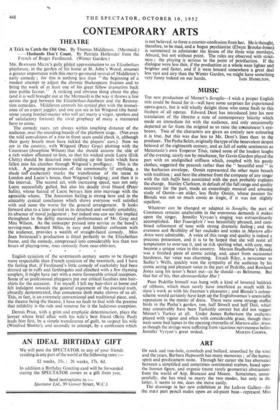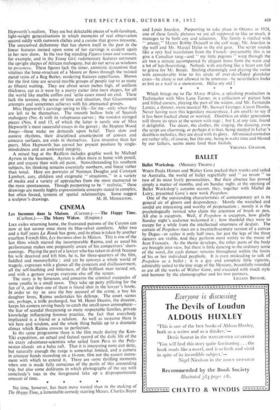ART
OF rock and tree-bole, cromlech and bollard, smoothed by the wind and the years, Barbara Hepworth has many memories ; of the human spirit and predicament none. Through her career she has alternated between a simplified and sometimes sentimental realism, based upon the human figure, and organic (more rarely geometric) abstractions from the world of Arp, Brancusi and Moore. Sometimes, unsuc- cessfully, she has tried to marry the two modes, but only in the latter, it seems to me, does she move easily.
The drawings in her new exhibition at the Lefevre Gallery—for the most part pencil nudes upon an oil-paint base—represent Miss Hepworth's realism. They are but delectable pieces of wall-furniture, light-weight generalisations in which moments of real observation accord oddly with outworn clichés and a cuisine that grows tiresome. The unresolved dichotomy that has shown itself in the past in the linear features incised upon some of her carvings is evident again in her new show. In the two big standing Figures (man and woman), for example, and in the Young Girl, rudimentary features surmount the upright shapes of African mahogany, but do not serve as windows to presences. These figures lack the inner, animistic dynamism that vitalises the bone-structure of a Moore or flows through the twisted metal veinsof a Reg Butler, rendering features superfluous. Shown for the first time are several marble groups of people (up to as many as fifteen) waiting. They are about seven inches high, of uniform thickness, cut as it were by a pastry cutter into inert shapes, for all the world like marble coffins and 'cello cases stood on end. These lack the tension, the sense of time and situation, that Giacommetti attempts and sometimes achieves with his attenuated groups.
Miss Hepworth's carvings spring to life—for me—only when they are left to be themselves. The smooth hollow bole of Spanish mahogany (No. 4) with its voluptuous curves ; the wooden stringed pieces (Nos. 8 and 15, of which the latter is surely one of Miss Hepworth's most successful essays in the genre) ; the Hopton Wood Image—these make no demands upon belief. Their slow and austere rhythms, their disciplined counterpoint of convex and concave surfaces, are ends in themselves. Less inventive than her peers, Miss Hepworth has earned her present position by single- mindedness and an awkward integrity.
A mixed bag at the Redfern includes graphic work by Michael Ayrton in the basement. Ayrton is often more at home with pencil, pen and crayon than with oil paint. Notwithstanding his southern subjects, his thinking remains essentially northern, and linear rather than tonal. Here are portraits of Norman Douglas and Constant Lambert, cats, children and enigmatic " situations," in a variety of media and a variety of approaches from the most mannered to the most spontaneous. Though purporting to be " realistic," these drawings are mostly highly expressionistic concepts stated in complex, but often forced, systems of spatial relationships. Some suggest



































 Previous page
Previous page